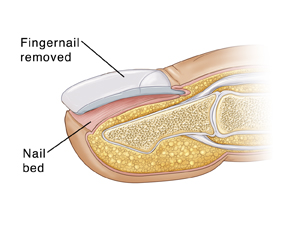Sometimes a toenail or fingernail may be removed because of injury, pain from an ingrown nail, or infection, or to look at abnormal tissue below the nail. After your nail has been removed, it will take a few weeks for the nail to start to grow back. It will take about 3 to 6 months for a fingernail to fully grow back. A toenail will take about 6 to 12 months. Nails will often, but not always, grow back normally.
Home care
These tips will help you care for yourself at home.
-
Keep the injured hand or foot raised above the level of your heart to help with pain and swelling. This is very important during the first 48 hours.
-
Apply an ice pack for up to 20 minutes every 3 to 6 hours during the first 24 to 48 hours. Keep using ice packs for swelling and pain relief as needed. To make an ice pack, put ice cubes in a plastic bag that seals at the top. Wrap the bag in a clean, thin towel or cloth. Never put ice or an ice pack directly on the skin. As the ice melts, be careful not to get any wrap, splint, or cast wet.
-
You can use over-the-counter medicine to control pain, unless another medicine was prescribed. Note: If you have chronic liver or kidney disease or ever had a stomach ulcer or gastrointestinal bleeding, talk with your provider before using these medicines. Don’t use ibuprofen in children under 6 months of age. Never give aspirin or products containing aspirin to children under 19 years old, as this may cause Reye syndrome. Reye syndrome is a rare but serious illness that may result in brain or liver damage or even cause death.
-
The nail bed (the tissue under the nail) is moist, soft, and sensitive. Protect the nail bed for the first 7 to 10 days until it dries out and becomes hard. Keep it covered with a nonstick dressing or adhesive bandage until that time.
-
Bandages tend to stick to a newly exposed nail bed. They can be hard to remove if left in place more than 24 hours. So change dressings every 24 hours, unless you were told otherwise. If needed, soak the dressing off while holding your finger or toe under warm running water. Applying petroleum jelly or an antibiotic ointment to the dressing may help keep it from sticking.
-
If you were given antibiotics to treat or prevent infection, take them as directed by your health care provider until they are all gone.
Follow-up care
Follow up with your health care provider, or as advised. If X-rays were taken, you'll be told of any new findings that may affect your care.
When to get medical advice
Contact your health care provider or get medical care right away if you have:
-
Pain or swelling that gets worse after 24 hours.
-
Redness around the nail.
-
Fluid draining from your finger or toe.
-
Any red streaks forming.
-
A fever of 100.4°F (38°C) or higher, or as advised by your provider.
-
Uncontrolled bleeding.


